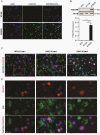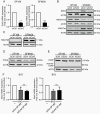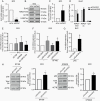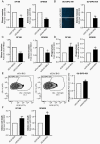Inhibition of microglial EZH2 leads to anti-tumoral effects in pediatric diffuse midline gliomas
- PMID: 34485907
- PMCID: PMC8409254
- DOI: 10.1093/noajnl/vdab096
Inhibition of microglial EZH2 leads to anti-tumoral effects in pediatric diffuse midline gliomas
Abstract
Background: Diffuse intrinsic pontine gliomas (DIPG), within diffuse midline gliomas are aggressive pediatric brain tumors characterized by histone H3-K27M mutation. Small-molecule inhibitors for the EZH2-H3K27 histone methyltransferase have shown promise in preclinical animal models of DIPG, despite having little effect on DIPG cells in vitro. Therefore, we hypothesized that the effect of EZH2 inhibition could be mediated through targeting of this histone modifying enzyme in tumor-associated microglia.
Methods: Primary DIPG tissues, and cocultures between microglia and patient-derived DIPG or -pediatric high-grade glioma (pHGG) cell lines, were used to establish the H3-K27M status of each cell type. Antisense RNA strategies were used to target EZH2 gene expression in both microglia and glioma cells. Microglia anti-tumoral properties were assessed by gene expression profile, tumor cell invasion capacity, microglial phagocytic activity, and associated tumor cell death.
Results: In primary DIPG tissues, microglia do not carry the H3-K27M mutation, otherwise characteristic of the cancer cells. Activation of a microglial tumor-supportive phenotype by pHGG, independently of their H3-K27M status, is associated with a transient H3K27me3 downregulation. Repression of EZH2 in DIPG cells has no impact on tumor cell survival or their ability to activate microglia. However, repression of EZH2 in microglia induces an anti-tumor phenotype resulting in decreased cancer cell invasion capability, increased microglial phagocytosis, and tumor-related cell death.
Conclusions: These results indicate that microglia, beyond the tumor cells, contribute to the observed response of DIPG to EZH2 inhibition. Results highlight the potential importance of microglia as a new therapeutic avenue in DIPG.
Keywords: DIPG; EZH2; H3K27me3; anti-tumoral; microglia.
© The Author(s) 2021. Published by Oxford University Press, the Society for Neuro-Oncology and the European Association of Neuro-Oncology.
Figures






References
-
- Louis DN, Perry A, Reifenberger G, et al. . The 2016 World Health Organization classification of tumors of the central nervous system: a summary. Acta Neuropathol. 2016;131(6):803–820. - PubMed
-
- Zaghloul MS, Eldebawy E, Ahmed S, et al. . Hypofractionated conformal radiotherapy for pediatric diffuse intrinsic pontine glioma (DIPG): a randomized controlled trial. Radiother Oncol. 2014;111(1):35–40. - PubMed
-
- Schwartzentruber J, Korshunov A, Liu XY, et al. . Driver mutations in histone H3.3 and chromatin remodelling genes in paediatric glioblastoma. Nature. 2012;482(7384):226–231. - PubMed
Grants and funding
LinkOut - more resources
Full Text Sources
